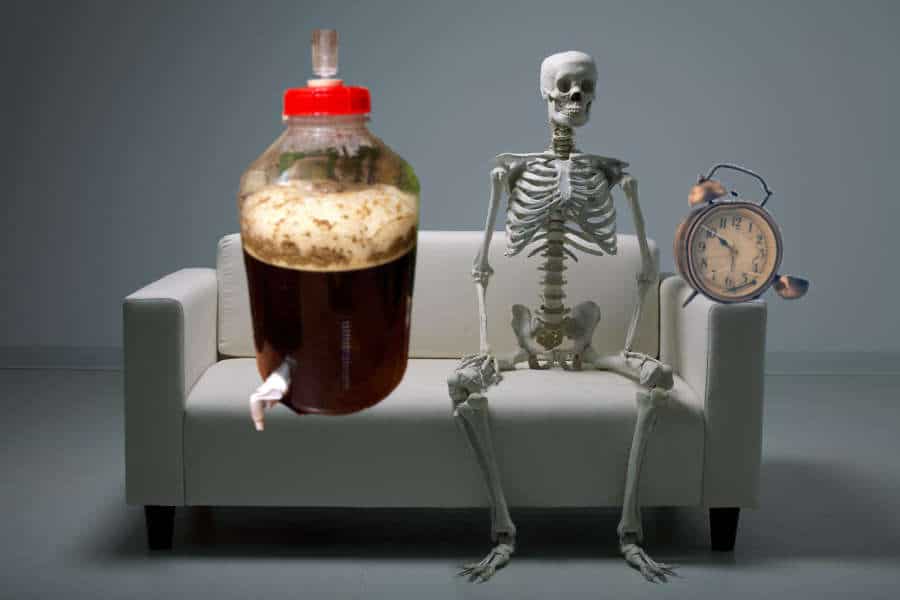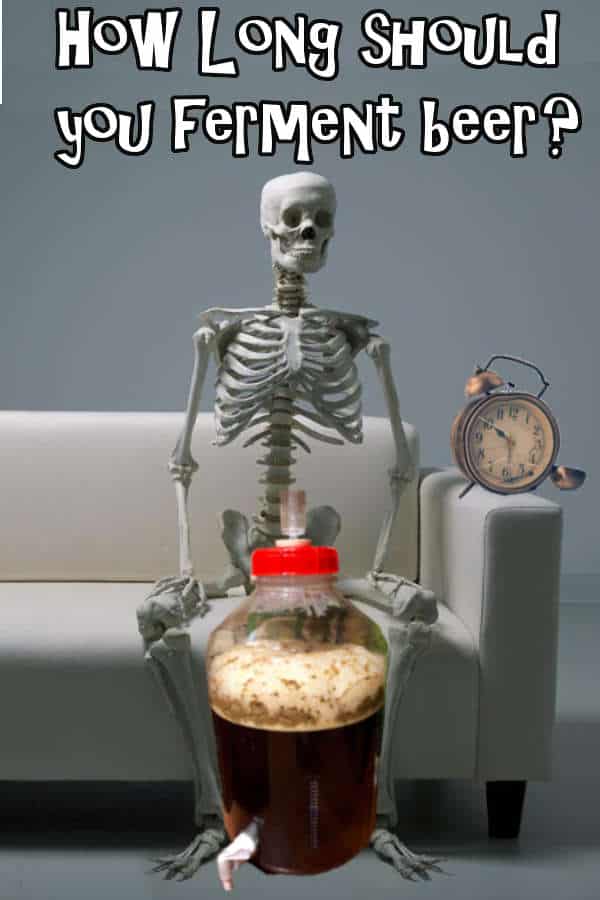Although from the outside brewing beer seems pretty badass and a very exciting hobby to have, most of the process involves waiting around (when you aren’t cleaning stuff).
The real star of the show is the yeast which actually turns your wort into beer. At times, the brewer just has to bow to the timetable set out by this fantastic fungus, but it doesn’t stop us feel eager for when we can taste that first sip.
So, how long should you allow beer to ferment and is there a limit to fermentation time?
The simple answer is that fermentation has no limit and takes along as the yeast takes to transform sugars into ethanol and CO2. When fermentation ends, it’s ok for the beer to sit in the fermenter for days afterward. However, beer will not fully carbonate on its own in a fermenter unaided.
For many new homebrewers, knowing the ins and outs of fermentation can be a baffling experience and it is possible to run into quite a few undesirable scenarios if you do the wrong thing.
What I’ve done in this article is to answer the most common questions I hear about fermentation from how long is too long to when you know it’s actually done and dusted.
NOTE: I’d just like to clarify a brewing term before I continue, we call the mixture we produce after mashing ‘wort‘, but when we pitch that wort just before fermentation it is then known as ‘beer‘. This is my understanding of the terminology and what’ll use in this article.
Shop for your brewing ingredients online at homebrewing.org.
How do I know if my beer is fermenting?

There are several indications that beer is fermenting and they fall into visual, chemical and physical signs.
Visual signs
Most beers as they begin to ferment will build up a thick foamy crust on their surface of proteins, hop resin and, sadly, dead yeast. When you see this then you can be quite sure that something good is happening in your fermenter. However, the lack of krausen isn’t a sign in itself that NOTHING is happening. So, don’t just rely on this.
Chemical signs
As yeast converts sugars in the beer into lovely ethanol alcohol, a by-product of this is also carbon dioxide. In order to avoid exploding fermenter and carboys across the world, brewers use what is known as an airlock.
This allows gases to escape the fermenter but doesn’t allow unwanted oxygen to enter. So, if your airlock is bubbling away, then you can also be sure that your yeast is hard at work. Nevertheless, a lack of bubbles or the sudden stopping of a bubbling airlock doesn’t mean that your fermentation is over.
Physical signs
The only accurate way to determine if fermentation is taking place or is over is to measure the gravity of the beer. By this, we mean the density of the liquid, which tells us what additional compounds are in it. When the gravity moves towards our target final gravity we can tell that enough sugars have been ingested by the yeast and so our fermentation is complete.
This is the best and only method to base your decision on when to transfer your beer out of your fermentation vessel and into bottles or a keg (or your secondary fermentation container if that’s what you are doing).
How long can I leave my beer in the fermenter?
There is no set limit to how long you can leave your beer in the fermenter while or after fermenting it. Although beer definitely has a shelf-life, if it is kept at optimal temperatures in the fermenter then the yeast will continue to work on the sugars in the beer and break down other compounds as well.
However, it is worth remembering that your beer is always at risk from bacteria even after it has fermented, and leaving it in the fermenter for longer than intended only extends this risk.
Is it a good idea to brew beer the day before traveling on vacation?
Despite the added stress, a pre-vacation brew day will have on your packing and organization for leaving, it’s not a bad idea in terms of homebrewing.
If you have a good brewing environment that maintains its temperature well and isn’t rushing to transfer your wort into the fermenter before pitching it, there is no issue with leaving the beer to ferment while out of town for a week or two.
The only issue will be if you are a new brewer and having quite mastered the pitching process. You may only discover when you return home that your beer needed a little extra yeast to do the job, at which point you’ll have to wait while you re-pitch your beer and then really starts fermenting.
Most importantly, don’t forget to get a good reading for your beer’s original gravity before you leave on your trip. This will instantly tell you that your beer has adequately been fermented when you return and take a final gravity reading.
What happens if you ferment beer too long?
It’s not really possible to ‘over-ferment’ beer purely because of the nature of yeast. By this I mean, brewer’s yeast is a very picky eater. They will only feast on certain types of sugars present in the beer and when they have done this they will naturally gravitate together (flocculation) and then sink to the bottom of the fermenter. Yeast doesn’t die when it does this, but merely lie dormant until more food becomes available (priming during bottling for example).
However, beer could be considered to be ‘over-fermented’ only when wild yeast is introduced in the form of an infection. Wild yeast is the sort of mold which grows on grapes and fruit and is sometimes actually used by some brewers actively. For most homebrewers, however, we don’t want wild yeast strains such as Saccharomyces diastaticus to be present in our beer as they can eat up the sugars which brewer’s yeast doesn’t and also give the beer off-flavors.
So, your beer is only ‘over-fermented’ if it tastes tart or too buttery or even like feet. If in doubt, after a week or so take a quick sample for your gravity reading and give it a taste. If it tastes beery, then you’re all good to keep it fermenting if you haven’t yet reached your target final gravity.
What if my beer stops bubbling?
It’s one of the most fascinating things about brewing beer when things start to happen in the fermenter. Your beer’s surface will foam and build and your airlock (which you should be using) will bubble away. But what happens if those bubbles stop, and most frightening of all if they stop after only a few hours or days?
Well, it’s like any other barbeque or Christmas dinner you’ve been too. When everyone first sits down they are starving and eagerly wolf down anything they can get their hands on. As the meal continues and everyone is reaching their fill, the eating slows down. Then again, after the gift-giving and parlor games, you all want another turkey sandwich. OK, you get the picture and it’s the same with yeast.
Bubbling may be very vigorous at the start of fermentation and then it may tail off. That doesn’t mean the yeast has stopped working, but they may just have slowed down the rate at which they are converting those sugars into ethanol and CO2.
When in doubt, take a gravity reading with your hydrometer and then a day or so later, take another one. (Not sure how to do this, see my article on how to use a hydrometer). If the reading remains the same then it may indicate that your fermentation has finished. If this is the case but you haven’t reached your target final gravity, and it’s a long way off, you may have a ‘stuck fermentation’. Check out my article here to see what to do if this has happened to you.
Can you ferment beer in 4 days or less?
Although there are some strains of yeast that may convert sugars into alcohol faster than others, a speedy fermentation may not be that desirable.
It’s not unknown for some recipes to take only 4 days to achieve the target final gravity the brewer wanted. However, this can only be determined by taking accurate gravity readings of the beer and waiting at least 24 hours between readings to check the gravity doesn’t change. Don’t take a bubbling airlock, or lack of one, for any indication of the progress of fermentation
Even if your beer appears to be done after 4 days, I highly advise that you let it sit for at least another 7 to 14 days to allow the yeast to work on the rest of the sugar in it, even if it does so much more slowly than before.
How long does it take for beer to clear?
The clarity of your finished beer is really determined by a few main factors, namely Proteins, Polyphenols, yeast, and temperature.
If you are brewing a beer other than a delicious Hefeweizen or wheat beer, then it was likely intended not to be too cloudy. However, some beers use low-flocculating yeast which will remain suspended in the beer right through to beer tasting time.
A cloudy beer at the end of fermentation will likely clear during the bottling or kegging phases if stored at a cool temperature. This will give the yeast and other compounds time to settle at the bottom of the bottle or keg.
However, you can also use several substances know as ‘finings’ to encourage more clarity in your beer. These range in type and can be added at different times of the brewing process. For more information, go over to my full article on how to fix a cloudy or hazy beer. If you are vegetarian or vegan, or your future beer buddies are, then check out this article which tells you which fining substances to use and which to avoid.
Can you drink beer after fermentation?
As a rule of thumb, you can drInk beer (or wort) at any stage of the brewing process and in fact, I recommend that you do. Anytime you take a gravity reading, give that sample a taste. For new brewers, it will help you learn more about the beer you brew and as you gain experience you can instantly spot any issue you may be having with your beer.
Whether or not the beer will be enjoyable to drink is another matter. If you drink your beer directly after it’s been fermented, you will find it rather flat. Although the yeast will produce some CO2 during the process of fermentation, we allow most of that to escape through the airlock. It’s only during bottle conditioning or forced carbonation in a keg that the beer actually absorbed carbon dioxide and takes on the fizziness most of us enjoy.
Can you bottle beer if still bubbling?
If the airlock is still bubbling away when your beer recipe tells you that its time to bottle the beer, it may be wise to hold off for a couple of days. If you bottle beer which hasn’t yet finished fermenting, you may have a ticking time bomb on your hands. Literally. Check out my full article on what to do about exploding bottles and how to avoid bottling too early.
Just take a reading with your hydrometer and compare it to your target final gravity, then leave your beer for at least 24 hours before repeating the process. If there was no change, then you may wish to confirm one more time before bottling. If there was a change in the gravity reading, it’s more than likely that you just experiencing a slower fermentation process with this batch. Be patient for a few more days and then take another reading.
Which type of beer takes the longest to ferment?
If you are brewing a beer with a higher ABV, then it’s going to take longer for the yeast to do its work. Most ales and lagers will take anywhere from between 2 and 3 weeks to finish the fermentation period. If you are brewing any beer with an alcohol content of more than 7%, you will have to be more patient than when brewing weaker strength beers.
Some varieties of beer, such as Belgian Gueuze, can be blended with batches that have been aged for many years, at which point the younger beer instigates renewed fermentation in the aged batch. So, this is a very long fermentation period indeed.






